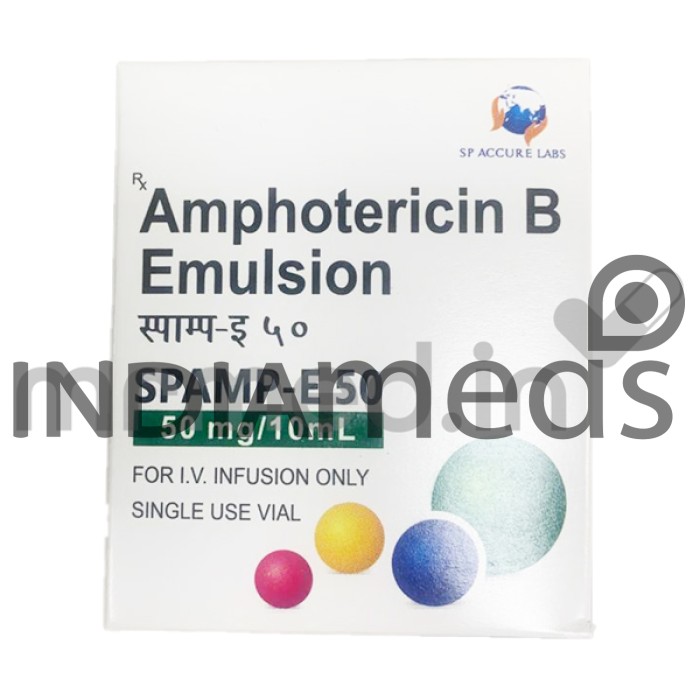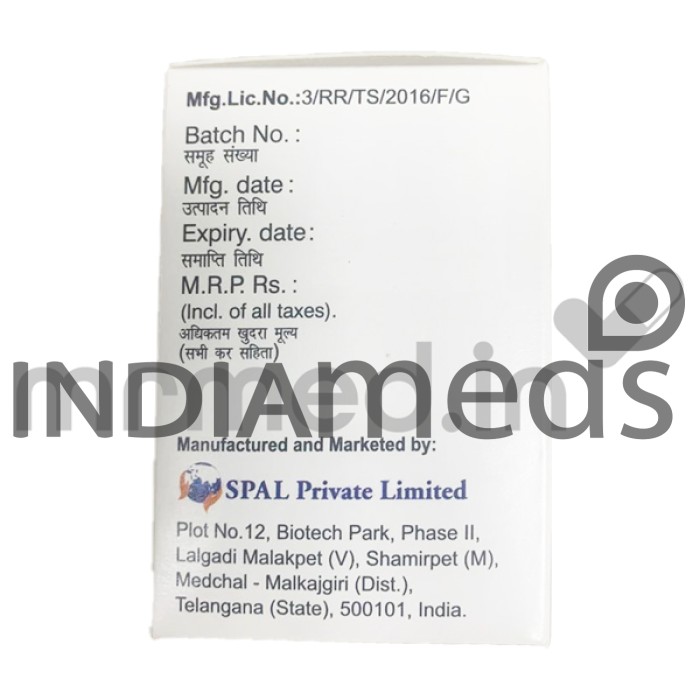Spamp-E-50 Amphotericin B is an antifungal medication containing the active ingredient Amphotericin B. It treats fungal infections of one or more deep body organs. It is also used to treat suspected fungal infections in patients with a raised temperature and neutropenia (reduced number of white blood cells). It is also indicated to treat visceral leishmaniasis, a disease caused by a parasite in certain people.
Do not receive this injection if you are allergic to Spamp-E-50 Amphotericin B or any of the other ingredients in the medicine. Inform your physician if you have a severe allergic reaction, kidney or liver problems, and if you are having dialysis. Tell your doctor if you have low potassium levels. This injection may cause severe infusion reactions such as flushing, itching, sickness, swelling of the face, mouth, tongue, and airways, and difficulty breathing. Inform your physician immediately if you face any of these symptoms.
Before initiating your first treatment, your physician may give you a small amount of Spamp-E-50 Amphotericin B to check for allergic reactions. This medicine contains sugar in each vial. Tell your doctor if you have diabetes. Inform your physician if you are pregnant or breastfeeding before initiating the treatment. Your doctor will decide the dose and quantity of this drug based on your disease condition.
Therapeutic Effects of Spamp-e 50 Amphotericin B
Pregnancy
If you are pregnant, suspecting, or planning for the pregnancy, consult your physician for more advice before taking Spamp-E-50 Amphotericin B. Physicians may prescribe this medicine only when it is needed.
Breast Feeding
If you are a breastfeeding mother, it's important to consult with your doctor before taking Spamp-E-50 Amphotericin B.
Lungs
It is unknown whether Spamp-E-50 Amphotericin B is safe for patients with lung problems. Inform your physician if you have lung disease before starting the treatment.
Liver
It is unknown whether Spamp-E-50 Amphotericin B is safe for patients with liver problems. Inform your physician if you have liver disease before starting the treatment.
Alcohol
It is unknown whether consuming alcohol while taking Spamp-E-50 Amphotericin B is safe. Please speak with your physician.
Driving
Some side effects of Spamp-E-50 Amphotericin B may impair your ability to drive or operate machinery safely. It is unsafe to consume this drug.
Serious
- Serious allergic reactions (sudden onset of itching, rash or hives on the skin, shortness of breath and wheezing)
- Increased blood sugar levels
- Decreased potassium levels
- Shortness of breath,
- Fever, chills, or shivering
Common
- Headache
- Dizziness
- Diarrhea
- Nausea
- Indigestion
- Abdominal Pain
While Spamp-E-50 Amphotericin B is generally well-tolerated, it can still have side effects. Common side effects may include fever, chills, headache, nausea, vomiting, increased blood sugar levels, muscle or joint pain, and infusion-related reactions. In rare cases, it may cause more serious side effects such as cardiac arrest, kidney damage or allergic reactions.
Spamp-E-50 Amphotericin B can be used in babies more than 1 years old, but the dosage and administration may vary depending on the child's age, weight, and specific medical condition. It is crucial to follow the healthcare provider's instructions and closely monitor the child's response to treatment.
Spamp-E-50 Amphotericin B is less toxic because it is less nephrotoxic. Low toxicity of this medicine may be due to the small number of binding receptors in the drug.
One of the key advantages of Spamp-E-50 Amphotericin B is its lower toxicity compared to conventional drugs. This makes it a preferred choice, especially for patients more susceptible to antifungal medications' side effects. Additionally, this drug has a prolonged circulation time in the body, allowing for less frequent dosing.
Even if you feel better, do not discontinue taking Spamp-E-50 Amphotericin B without consulting your doctor. Before the illness is treated, your symptoms may improve. As a result, it is recommended that you continue your treatment for the suggested term for better and more complete treatment.
Molecule name: Amphotericin B | Therapeutic class: Antifungal agents |
Pharmacological class: Polyene antifungals | Indications: Treatment of fungal infections |





